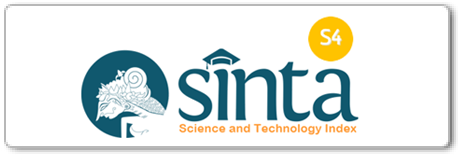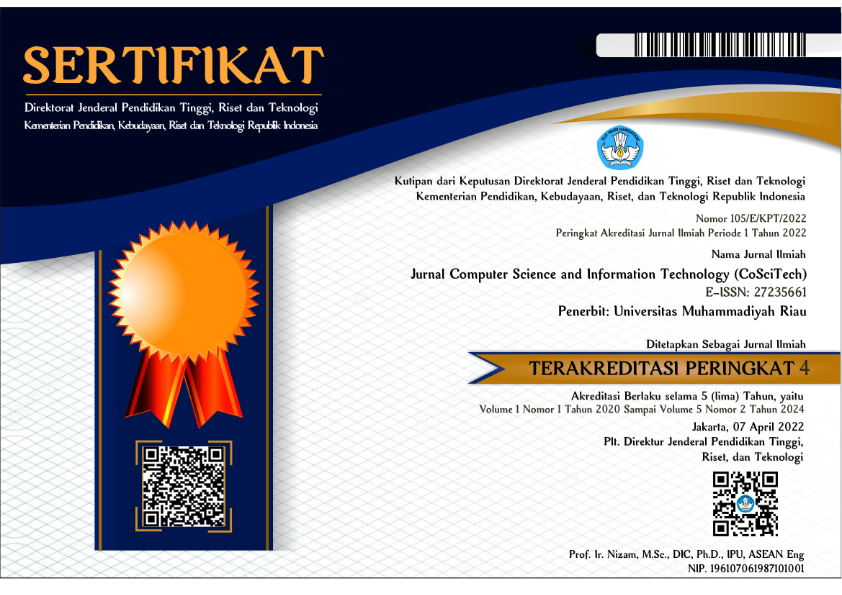Bahasa Indonesia Analysis of public opinion sentiment regarding the use of maxim service using the naïve bayes algorithm
DOI:
 https://doi.org/10.37859/coscitech.v4i3.6194
https://doi.org/10.37859/coscitech.v4i3.6194
Abstract
Technology is developing very quickly, as is happening in the field of transportation. Currently, transportation has begun to develop with the presence of various online-based transportation. One type of transportation that is widely used is the online motorcycle taxi application called Maxim. This online transportation service is one of the topics that is starting to be widely discussed via Twitter social media. By knowing these sentiments, users can determine whether the online transportation service provider is well received or not. The method used in this research is using the Naïve Bayes algorithm. The aim of this research is to conduct sentiment analysis of public responses regarding online transportation services, namely Maxim. Based on the research results, in evaluation testing, the accuracy results are obtained, namely for negative sentiment getting 87% precision, 74% recall, and 80% f1-score. Meanwhile, positive sentiments get 80% precision, 90% recall, and 85% f1-score. The sentiment results are dominated by positive sentiment, which is as many as 616 data.
Downloads
References
[2] R. A. Tsalisa, S. P. Hadi, and D. Purbawati, “Pengaruh Kualitas Pelayanan dan Harga terhadap Kepuasan Pelanggan Pengguna Jasa Transportasi Online Maxim di Kota Semarang,” J. Ilmu Adm. Bisnis, vol. 11, no. 4, pp. 822–829, 2022, doi: 10.14710/jiab.2022.35970.
[3] N. Anggi Pranata, “Klasifikasi Sentimen Terhadap Maxim Menggunakan Algoritma SVM Pada Media Sosial TwittAnggi Pranata, N. (2022). Klasifikasi Sentimen Terhadap Maxim Menggunakan Algoritma SVM Pada Media Sosial Twitter. Klasifikasi Sentimen Terhadap Maxim Menggunakan Algorit,” Klasifikasi Sentimen Terhadap Maxim Menggunakan Algoritm. SVM Pada Media Sos. Twitter, vol. 5, no. 3, pp. 332–341, 2022.
[4] M. Dwijayanti, F. Noor Hasan, and R. Zein Adam, “Analisis Sentimen Pada Ulasan Pelanggan Menggunakan Metode Naïve Bayes Classifier (Studi Kasus: Grab Indonesia),” Pros. Semin. Nas. Teknoka, vol. 6, no. 2502, pp. 93–99, 2022, doi: 10.22236/teknoka.v6i1.441.
[5] Fitri Wulandari, Elin Haerani, Muhammad Fikry, and Elvia Budianita, “Analisis sentimen larangan penggunaan obat sirup menggunakan algoritma naive bayes classifier,” J. CoSciTech (Computer Sci. Inf. Technol., vol. 4, no. 1, pp. 88–96, 2023, doi: 10.37859/coscitech.v4i1.4781.
[6] D. R. Alghifari, M. Edi, and L. Firmansyah, “Implementasi Bidirectional LSTM untuk Analisis Sentimen Terhadap Layanan Grab Indonesia,” J. Manaj. Inform., vol. 12, no. 2, pp. 89–99, 2022, doi: 10.34010/jamika.v12i2.7764.
[7] F. A. Wenando et al., “Jurnal Computer Science and Information Technology ( CoSciTech ) Analyzing Public Sentiment on the Brigadier J Shooting Case Using the Naïve Bayes Classifier Algorithm,” vol. 4, no. 2, pp. 484–490, 2023.
[8] D. Darwis, N. Siskawati, and Z. Abidin, “Penerapan Algoritma Naive Bayes Untuk Analisis Sentimen Review Data Twitter Bmkg Nasional,” J. Tekno Kompak, vol. 15, no. 1, p. 131, 2021, doi: 10.33365/jtk.v15i1.744.
[9] F. V. Sari and A. Wibowo, “Analisis Sentimen Pelanggan Toko Online Jd.Id Menggunakan Metode Naïve Bayes Classifier Berbasis Konversi Ikon Emosi,” J. SIMETRIS, vol. 10, no. 2, pp. 681–686, 2019.
[10] S. R. Hakim, M. A. Rizki, N. I. Zekha F, N. Fitri, Y. R. A, and R. Nooraeni, “Analisis Sentimen Pengguna Instagram Terhadap Kebijakan Kemdikbud Mengenai Bantuan Kuota Internet Dengan Metode Support Vector Machine (Svm),” J. MSA ( Mat. dan Stat. serta Apl. ), vol. 8, no. 2, p. 15, 2020, doi: 10.24252/msa.v8i2.16795.
[11] R. A. Puspala Sari and I. D. Jaya, “Penerapan Algoritma Naïve Bayes Untuk Analisis Sentimen Pengguna My JNE,” J. Multidisiplin West Sci., vol. 2, no. 03, pp. 215–221, 2023, doi: 10.58812/jmws.v2i03.269.
[12] R. Nadia, D. K. M. L, and M. . Fhira Nhita, S.T., “Analisis Dan Implementasi Algoritma Naïve Bayes Classifier Terhadapa Pemilihan Gubernur Jawa Barat 2018 Pada Media Online,” e-Proceeding Eng., vol. 5, no. 1, pp. 1678–1700, 2018.
[13] N. Fitriyah, B. Warsito, and D. A. I. Maruddani, “Analisis Sentimen Gojek Pada Media Sosial Twitter Dengan Klasifikasi Support Vector Machine (Svm,” J. Gaussian, vol. 9, no. 3, pp. 376–390, 2020, doi: 10.14710/j.gauss.v9i3.28932.
[14] D. Normawati and S. A. Prayogi, “Implementasi Naïve Bayes Classifier Dan Confusion Matrix Pada Analisis Sentimen Berbasis Teks Pada Twitter,” J. Sains Komput. Inform. (J-SAKTI, vol. 5, no. 2, pp. 697–711, 2021.
[15] R. Julianto, E. D. Bintari, and I. Indrianti, “Analisis Sentimen Layanan Provider Telepon Seluler pada Twitter Menggunakan Metode Naïve Bayesian Classification,” J. Big Data Anal. Artif. Intell., vol. 3, no. 1, pp. 23–30, 2017.














